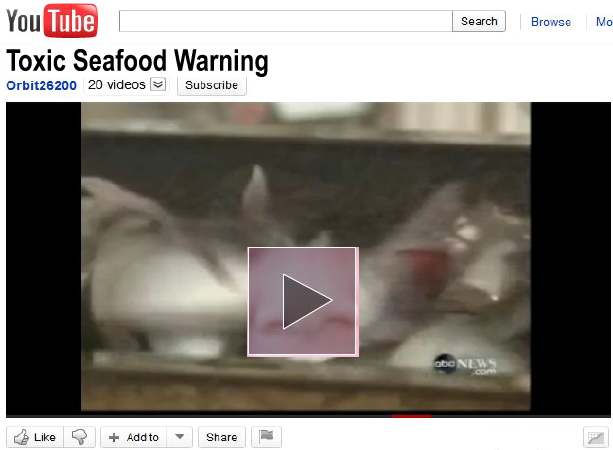
News
Behind the Headlines
Two-Cents Worth
Video of the Week
News Blurbs
Articles
Testimony
Bible Questions
Internet
Articles (2012)
Internet Articles (2011)
Internet Articles (2010)
Internet Articles
(2009)
Internet Articles (2008)
Internet Articles (2007)
Internet Articles (2006)
Internet Articles (2005)
Internet Articles (2004)
Internet Articles (2003)
Internet Articles (2002)
Internet Articles (2001)


![]()
When 7-year old Julie Murphy
opened her lemonade stand at a
local art fair in Portland, Oregon on a hot August day last year,
her lemonade stand was visited by a health department bureau-
crat with a clipboard—and a nasty disposition. The bureaucrat
told Julie's mom that they had to shut down the lemonade stand
or face a $500 fine from the Multnomah County Health Dept. What
does that have to do with fish? Watch the video, then read below.

Let's
begin with the video. 80% of the seafood sold in supermarkets in the United
States comes from third world nations. Last December (2010) NBC Nightly
News investigated the dangers found in tainted seafood from countries
like Bangladesh and Thailand. An ABC Atlanta News report did the same,
adding Indonesia, China, Taiwan, Malaysia, Indonesia and even Costa Rica.
What both investigations revealed is that while 80% of all the fresh seafood
you buy comes from the emerging nations, the Food & Drug Administration
[FDA] inspects less than 2% of it. What imported seafood it does inspect,
at least half the time, it finds that it is infected with salmonella or
listeria, or toxic chemicals—including toxic levels of veterinarian
drugs that are introduced into the contaminated water to keep the fish
alive until they are ready for market. State Health Dept. tests in Oklahoma,
Mississippi and Georgia found similar results.
ABC News reported
that catfish from China were contaminated with veterinarian drugs. Swordfish
from Vietnam—poisonous. Red snapper from Malaysia—filth contaminated.
Alabama's Agriculture Commissioner, Ron Sparks, went to Vietnam
and witnessed first hand fish farmed in dirty sewage water The sewage
was pumped with so many antibiotics that the water—and the fish—literally
became toxic.  One
of the things John Pruitt of WSB-TV, an ABC affiliate, reported
that one of the things found in imported fish is a fungicide called Malachite
Green. Malachite Green is illegal in the United States because it causes
both cancer and birth defects. Food safety advocates are constantly warning
the American people that the FDA, which has been in bed with the barons
of business and the princes of industry almost since its creation by Franklin
D. Roosevelt in 1935, is
not doing enough to protect the American consumers from the princes of
industry and the barons of business. Which is why some, but not yet all,
of the States now inspect the seafood coming into their sovereign territory
from the third world.
One
of the things John Pruitt of WSB-TV, an ABC affiliate, reported
that one of the things found in imported fish is a fungicide called Malachite
Green. Malachite Green is illegal in the United States because it causes
both cancer and birth defects. Food safety advocates are constantly warning
the American people that the FDA, which has been in bed with the barons
of business and the princes of industry almost since its creation by Franklin
D. Roosevelt in 1935, is
not doing enough to protect the American consumers from the princes of
industry and the barons of business. Which is why some, but not yet all,
of the States now inspect the seafood coming into their sovereign territory
from the third world.
Sparks was one of the first State Agriculture Commissioners to institute a seafood safety testing program. Since initiating the program, 50% to 60% of all fish imports into Alabama are now rejected due to some form of contamination that may cause serious health issues for Americans over time.
While supermarkets are now required to post the country of origin for fresh seafood where shoppers can see it, restaurants are not. And, remember this about restaurants. Like all retail establishments, restaurants are first and foremost concerned about their profit margins. That means, the cheaper the seafood the higher the profit margin. And, when you get the food, properly cooked and artfully plated in your favorite seafood restaurant, or boxed in your supermarket frozen food section, you not only don't know where the seafood came from, you have no idea if any of these contaminants that might be in them. You can't see them, you can't smell them, and you can't taste them. Nor can you cook them out of the food.
So how dangerous are these chemicals? According to Jeff Rosen from NBC News, scientists say that over time, eating the mentioned tainted seafood can cause anemia, cancer, and even birth defects. The FDA—which is still testing less than 2% of the seafood that comes into our ports—said the affects are long term and not fully understood. (The FDA refused to speak with either ABC or NBC on camera, saying only that it's doing the best it can.)
 Now,
back to 7 year old Julie Murphy who was selling lemonade at 50¢
a glass at the Last Thursday Art Show in Portland, Oregon. A clipboard
toting health inspector, checking food vendors to make sure they had their
$120 temporary restaurant license, told Julie's mother, Maria
Fife, to shut down her daughter's lemonade stand or face a $500 fine.
Because Fife wasn't moving fast enough to suit her, the health
inspector returned a short later with another clipboard dignitary and
threatened her again. This time, Fife and her daughter left.
Now,
back to 7 year old Julie Murphy who was selling lemonade at 50¢
a glass at the Last Thursday Art Show in Portland, Oregon. A clipboard
toting health inspector, checking food vendors to make sure they had their
$120 temporary restaurant license, told Julie's mother, Maria
Fife, to shut down her daughter's lemonade stand or face a $500 fine.
Because Fife wasn't moving fast enough to suit her, the health
inspector returned a short later with another clipboard dignitary and
threatened her again. This time, Fife and her daughter left.
Jon Kawaguchi, the Multomah County Environmental Health Supervisor defended his bureaucrat by telling the Oregonian newspaper that she was justified in closing down the lemonade stand because at a Florida shrimp festival in 2007, 48 people got sick after drinking lemonade sold at a lemonade stand by high school cheerleaders. (After what you just read about Thailand and Indonesian shrimp, which do you think was the culprit at the shrimp festival?) And, in 2003 a small group of people got sick at a family reunion. Lemonade was blamed because, the Health Dept. said, the lemonade was made with untreated water. However, the on-the-ground investigators suggested several other foods and beverage items that may have been responsible. In other words, there was no apparently physical evidence that the lemonade was the culprit.
But, what I found most amazing about both parts of this story—the lemonade and the imported seafood—is just how fast leftwing bureaucrats will pounce on a 7-year old girl and her mother to "protect" the health and safety of the consumers-at-large, but when wealthy importers bring seafood into the country that the FDA and the USDA know is not only unhealthy but dangerous to consume, the the federal government still drags its heels on banning the importation of gilled-garbage from countries with histories and reputations for selling seafood not fit for human consumption.
The American people need to wake up to the fact that the FDA is an American bureaucracy that has no jurisdiction outside of the nation's borders and no power not granted it through Congress by the princes of industry and barons of business. So, while the food growers, food processors, and the fisherman who provide you with the "catch-of-the-day," are required to obey the Food & Drug Administration's regulations, it's important to realize that their lobbyists write those regulations. And, by the way, the fish mongers in China, Thailand, Indonesia, Taiwan, Malaysia, and Bangladeshi don't have to listen to the FDA and the USDA because they don't live here. And, of course, by that time it's too late since the food the should have been banned before it arrived to a supermarket or restaurant in the United States is already on your dinner plate.
And, finally, America needs to remember that when they buy food products from outside the United States, it is the old adage, "buyer beware." Never assume that the health and safety rules imposed on the dwindling number of manufacturers and food processors still in the United States applies to the products that come from other countries. The European Union today now inspects 100% of the seafood products from the third world and rejects over 50% of them. The United States needs to do the same.

Copyright © 2009 Jon Christian Ryter.
All rights reserved.